Apple Hearing Study: Supporting innovations in hearing health
This study update from Apple highlights recent hearing health innovations that were supported by the Apple Hearing Study.
Hearing loss is the third most common chronic health condition, affecting nearly a quarter of Americans (1) and more than 1.5 billion people globally (2). If not detected or treated, hearing loss can affect health and well-being, impairing daily communication, affecting social, physical, and cognitive function (2,3). Hearing loss in adults is associated with increased risk of cognitive decline (4), dementia (5), falls (6), and other adverse health outcomes (2,3). Declines in age-related hearing health often occur slowly and may not be noticed by the affected individual (7).
To advance our understanding of the many factors that can affect hearing health, Apple launched the Apple Hearing Study in 2019 in collaboration with the University of Michigan School of Public Health and the World Health Organization (WHO) (8-10). Contributions from the more than 160,000 adults in the US participating in this study have helped identify the high prevalence of hearing loss among participants, and highlighted challenges that exist today in accessing hearing testing and assistive technologies (8-10). The contributions of study participants have shown that:
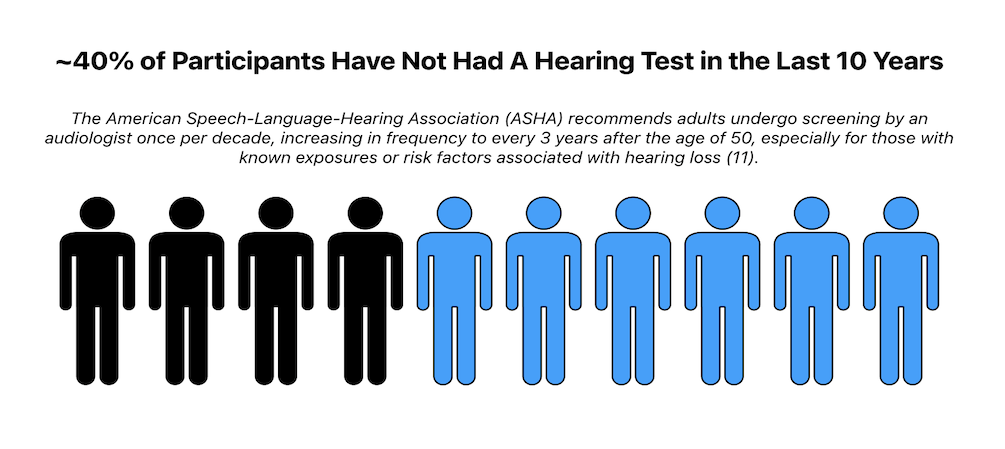
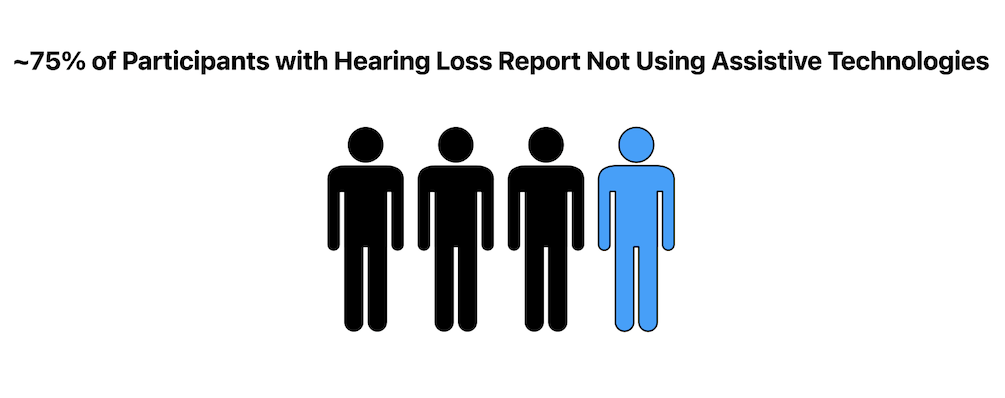
Inspired by the gaps in access to hearing related healthcare, such as those identified
in the Apple Hearing Study, Apple recently released a Hearing Protection feature,
an over-the-counter (OTC) self-administered hearing test, and a clinical grade OTC
self-fitting hearing aid.
Hearing Test feature is an OTC hearing assessment application designed to provide an accurate and convenient way to regularly monitor and evaluate hearing levels. Developed by Apple for use with AirPods Pro 2, the Hearing Test Feature is comparable to industry-standard professionally administrated hearing tests and is compatible with iPhone and iPad. The feature is intended for individuals 18 years of age and older. Audiograms from the Apple Hearing Study were used to help develop the algorithm used in the Hearing Test Feature. Additionally, Apple designed and completed dedicated clinical research studies separate from the Apple Hearing Study to validate this feature.
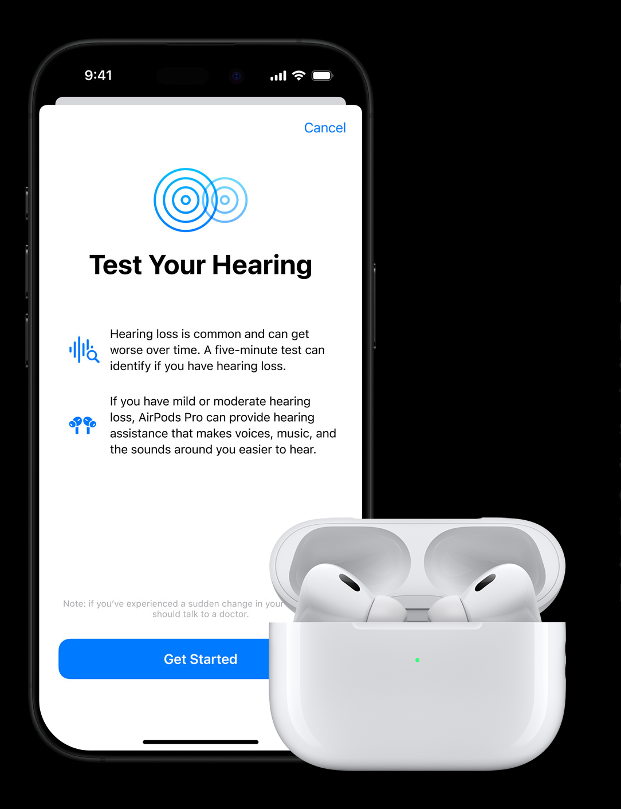
Hearing Aid feature is an OTC hearing aid cleared by the FDA for use by individuals 18 years of age and older, with perceived mild to moderate hearing loss. It is supported on AirPods Pro 2 paired with iPhone and iPad devices. Feature onboarding facilitates importing an audiogram from the Health app and allows users to customize their hearing aid settings and uses machine learning to make real-time adjustments during use. People with more severe degrees of hearing loss are recommended to seek care from a hearing healthcare professional.
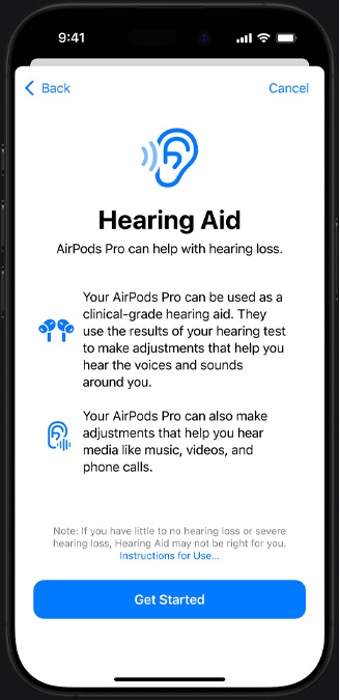
Hearing Protection is another recently released feature on AirPods Pro 2 that can help reduce exposure to loud environmental noise by attenuating sounds to lower levels in environments up to 110 decibels. Data on noise exposure from the Apple Hearing Study was used to assess the likelihood of exposure to different noise levels. To view your noise exposure information you can visit the Health app on iPhone and iPad to see health data and trends, including Headphone Audio Levels, Environmental Sound Levels (from the Noise app on Apple Watch), and Environmental Sound Reduction.
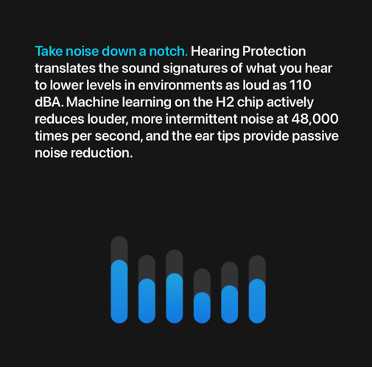
Summary
Hearing loss, a common and treatable sensory deficit, is associated with impaired
quality of life and greater incident morbidity across a range of health conditions,
including dementia, social isolation, and falls (2). Hearing loss from noise exposure
is completely preventable. Challenges in accessing traditional audiological testing
and hearing assistive technologies such as those identified by participants in the
Apple Hearing Study informed the development of the new hearing health features on
AirPods Pro 2. These are intended to enable and expand access to hearing testing,
hearing protection, and hearing assistive technologies. Your participation and contributions
to the Apple Hearing Study are much appreciated.
Thank you from the Apple Team!
References
- Lydia M. Haile, Aislyn U. Orji, Kelly M. Reavis, Paul Svitil Briant, Katia M. Lucas, Fares Alahdab, Till Winfried Bärnighausen, Arielle Wilder Bell, Chao Cao, Xiaochen Dai, Simon I Hay, Golnaz Heidari, Ibraheem M Karaye, Ted R. Miller, Ali H. Mokdad, Ebrahim Mostafavi, Zuhair S. Natto, Shrikant Pawar, Juwel Rana, Allen Seylani, Jasvinder A. Singh, Jingkai Wei, Lin Yang, Kanyin Liane Ong, Jaimie D Steinmetz, and GBD 2019 USA Hearing Loss Collaborators. 2024. “Hearing Loss Prevalence, Years Lived With Disability, and Hearing Aid Use in the United States From 1990 to 2019: Findings From the Global Burden of Disease Study.” Ear and Hearing 45, no. 1 (January/February): 257-267. pubmed.ncbi.nlm.nih.gov/37712826/
- World Health Organization. 2021. “World report on hearing.” www.who.int/publications/i/item/9789240020481
- Dan G. Blazer, Sarah Domnitz, and Catharyn T. Liverman, Editors. National Academies of Sciences Engineering and Medicine. Hearing health care for adults: priorities for improving access and affordability. Washington, DC: National Academies Press, 2016. www.ncbi.nlm.nih.gov/books/NBK367633/
- David G. Loughrey, Michelle E. Kelly, George A. Kelley, Sabina Brennan, and Brian A. Lawlor. 2018. “Association of Age-Related Hearing Loss With Cognitive Function, Cognitive Impairment, and Dementia: A Systematic Review and Meta-analysis.” JAMA Otolaryngology–Head & Neck Surgery 144, no. 2 (February): 115-126. pubmed.ncbi.nlm.nih.gov/29222544/
- Gill Livingston, Jonathan Huntley, Kathy Y. Liu, Sergi G. Costafreda, Geir Selbæk, Suvarna Alladi, David Ames, Sube Banerjee, Alistair Burns, Carol Brayne, Nick C. Fox, Cleusa P. Ferri, Laura N. Gitlin, Robert Howard, Helen C. Kales, Mika Kivimäki, Eric B. Larson, Noeline Nakasujja, Kenneth Rockwood, Quincy Samus, Kokoro Shirai, Archana Singh-Manoux, Lon S. Schneider, Sebastian Walsh, Yao Yao, Andrew Sommerlad, and Naaheed Mukadam. 2024. “Dementia prevention, intervention, and care: 2024 report of the Lancet standing Commission.” Lancet 404, no. 10452: 572-628. pubmed.ncbi.nlm.nih.gov/39096926/
- Nicole Tin-Lok Jiam, Carol Li, and Yuri Agrawal. 2016. “Hearing loss and falls: A systematic review and meta-analysis.” Laryngoscope 126, no. 11 (November): 2587-2596. pubmed.ncbi.nlm.nih.gov/27010669/
- Frank R. Lin. 2024. “Age-Related Hearing Loss.” New England Journal of Medicine 390, no 16 (April): 1505-1512. pubmed.ncbi.nlm.nih.gov/38657246/
- Richard L. Neitzel, Lauren Smith, Linyan Wang, Glenn Green, Jennifer Block, Michael Carchia, Kuba Mazur, Glen DePalma, Reza Azimi, and Blanca Villanueva. 2022. “Toward a better understanding of nonoccupational sound exposures and associated health impacts: Methods of the Apple Hearing Study.” Journal of the Acoustical Society of America 151, no. 3 (March): 1476-1489. pubmed.ncbi.nlm.nih.gov/35364926
- Apple Hearing Study (2022, March 3). “Celebrating World Hearing Day 2022.” sph-umich.shinyapps.io/world-hearing-day-2022/
- Apple Inc. “Health Privacy Overview: Learn how the Health app and HealthKit protect your privacy.” May 2023, apple.com/ios/health/pdf/Health_Privacy_White_Paper_May_2023.pdf
- Dang JC, Hsu NM. Hearing Loss Screening Guidelines. [Updated 2023 Nov 5]. In: StatPearls [Internet]. Treasure Island (FL): StatPearls Publishing; 2024 Jan-. Available from: https://www.ncbi.nlm.nih.gov/books/NBK597360/
